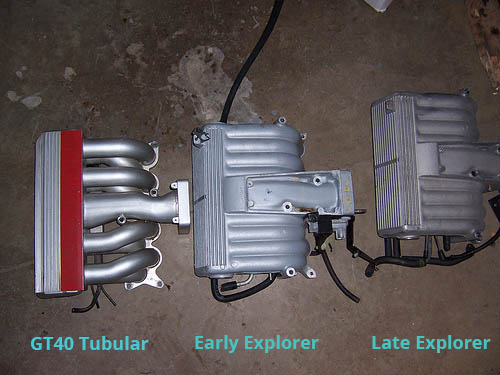There are a lot of terms floating around the internet regarding Ford intake manifolds, and perhaps is the reason why many find it a very confusing topic. In essence, there are 3 manifolds out there. There is the Cobra intake, which was the intake manifold installed on Mustang Cobras (real Cobras, 1993 only), the Explorer manifold (available on 95 Ford Explorers) and the third, the GT40 tubular intake manifold. Perhaps some of the confusion stems from the fact that both Ford Explorer and Ford Mustang Cobra engines are interchangeably called GT40 engines, due to their GT40 cylinder heads. In reality, the official 'GT40' intake was of a tubular design (AKA, very pretty), and was offered by Ford Racing via their aftermarket catalog. The GT40 intake did not come stock on any Mustang or Explorer, but it did come on 93-95 Lightnings. Still confused? Here is a summary below. Clicking the name of each manifold will open up a picture.
1) Cobra Intake, 1993 Mustang Cobra
2) Early Explorer Intake, 1995-97 Ford Explorer, Mountaineer
- Casting #RF-F87E-9K461-BA
3) Late Explorer Intake, mid-1997 Ford Explorer, Mountaineer
- Casting # RF-F87E-9K461-BB
4) GT40 Intake, FRPP Catalog OR 1993-95 Ford Lightning
FRPP Part #M-6001-A50, lower casting #RF-F87E, #RF-F3TE (lightning lower)
Tubular GT40 intakes from Ford Lightnings had a different plenum cover bolt pattern. Thereby, a cover from an FRPP GT40 will not fit on a Lightning, and vice versa. Furthermore, a Lightning lower will not fit on a Mustang 302 V8, as the Lightning lower is for a 351W V8.
More pictures
OK, that is where we can source the different intake manifolds. Now let's move on to actually describing each intake manifold in further detail, EGR and ACT provisions for the lower portions. Be forewarned, all Explorer engines used an EXTERNAL EGR setup, BUT, early-model Explorer intake manifolds have provisions for internal EGR.
